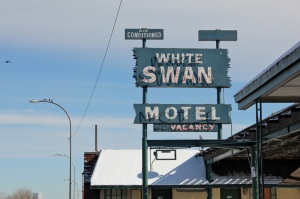Save the Signs is a movement founded by Corky Scholl to preserve and maintain the once-prominent neon signs that were, and still are a trademark of Colfax Avenue. In his own words, Corky beautifully describes the past, present, and future of these historic and unique works of art.
Neon lighting was invented in France in the early 1900s and the first neon sign in America appeared in California in 1923. After that, neon became a popular choice for commercial signs on well-traveled streets such as Denver’s Colfax Avenue.
Many of the neon signs that still exist on Colfax are remnants from the 1950s and 60s. They represent a time when Colfax was part of Route 40, the main route for cross-country travelers between New Jersey and San Francisco. This was a route familiar to Jack Kerouac and one he wrote about in his book On The Road. He would have seen hundreds of neon signs as he cruised through Aurora, Denver, and Lakewood on Colfax Avenue.
The large number of motels that still exist on Colfax is evidence of a time when travelers preferred this type of lodging and the amenities they offered, such as color TVs and telephones, amenities still advertised on the vintage motel signs that have survived along Colfax.
The construction of Interstate 70 rerouted traffic away from Colfax and many of the businesses along the old route suffered. The following decades saw a lack of investment along the corridor. This lead to what some refer to as “preservation by neglect.” Because development bypassed Colfax in the 70s, 80s and 90s, many examples of midcentury signage have survived to this day.
However, this trend is coming to an end. People are moving back into the urban core at a rapid rate. This surge of new residents is bringing a surge of redevelopment. This redevelopment is one of the factors threatening the neon signs along Colfax.
I started Save the Signs to build an appreciation for these signs and to create awareness that they’re valued in the community. If enough people support their preservation, the signs are more likely to survive into the future. Unlike modern signage, each of these neon signs is a one-of-a-kind work of art crafted from quality materials.
Ultimately, the fate of these signs rests with each individual property owner. They own the signs and can do with them as they please. Fortunately, signs are easier to preserve than historic buildings. Unlike buildings, signs can be purchased and moved if the need arises. Still, the preservation and restoration of these signs is not cheap. There are fewer neon craftsmen now than there were even a decade ago. Although neon isn’t currently in danger of dying out completely, it has definitely become more of a niche business.
There are many great signs on West Colfax. In Lakewood, Davies’ Chuck Wagon Diner is a classic that’s known throughout the country. The Big Bunny Motel has a great story and the crazed bunny holding a can of beer has captured the imaginations of countless passersby. The Trails End Motel and the Lakewood Lodge are also classic examples of midcentury motel signage. In Denver, the Aristocrat Motel and the Eddie Bohn’s Pig’n Whistle Motel signs stand side by side on West Colfax as reminders of a prosperous past.
It’s my hope that all of these signs will survive into the future. I feel this is a realistic goal and the ever-growing support from the community is testament to that.
For more information or to join the movement, head here: www.facebook.com/SaveTheSignsOnColfax
Photography: Barbara Gal
Check out Barbara’s latest exhibit at Denver International Airport, 45 Years in Colorado.







